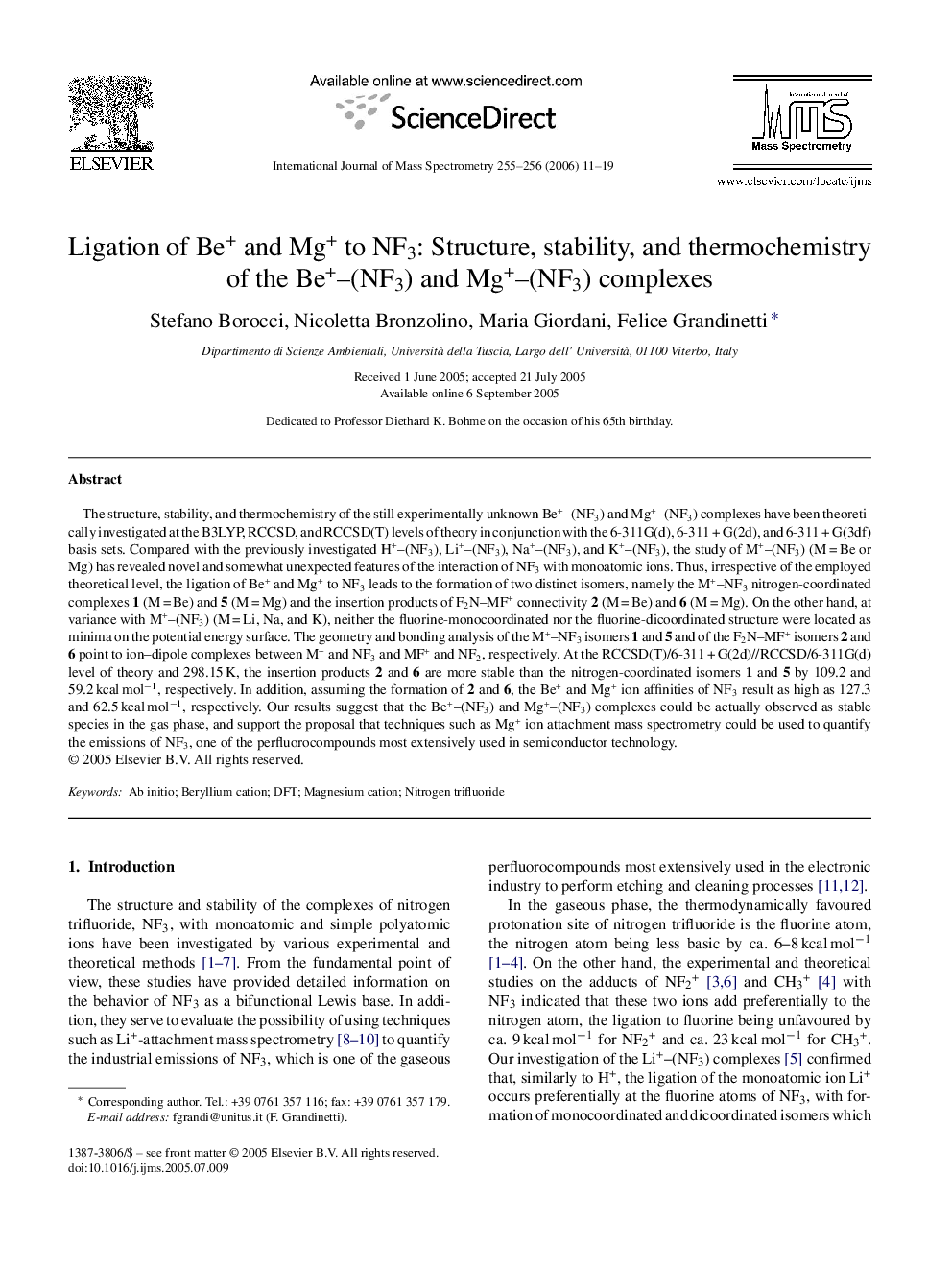| کد مقاله | کد نشریه | سال انتشار | مقاله انگلیسی | نسخه تمام متن |
|---|---|---|---|---|
| 1194717 | 1492384 | 2006 | 9 صفحه PDF | دانلود رایگان |
عنوان انگلیسی مقاله ISI
Ligation of Be+ and Mg+ to NF3: Structure, stability, and thermochemistry of the Be+-(NF3) and Mg+-(NF3) complexes
دانلود مقاله + سفارش ترجمه
دانلود مقاله ISI انگلیسی
رایگان برای ایرانیان
کلمات کلیدی
موضوعات مرتبط
مهندسی و علوم پایه
شیمی
شیمی آنالیزی یا شیمی تجزیه
پیش نمایش صفحه اول مقاله

چکیده انگلیسی
The structure, stability, and thermochemistry of the still experimentally unknown Be+-(NF3) and Mg+-(NF3) complexes have been theoretically investigated at the B3LYP, RCCSD, and RCCSD(T) levels of theory in conjunction with the 6-311G(d), 6-311 + G(2d), and 6-311 + G(3df) basis sets. Compared with the previously investigated H+-(NF3), Li+-(NF3), Na+-(NF3), and K+-(NF3), the study of M+-(NF3) (M = Be or Mg) has revealed novel and somewhat unexpected features of the interaction of NF3 with monoatomic ions. Thus, irrespective of the employed theoretical level, the ligation of Be+ and Mg+ to NF3 leads to the formation of two distinct isomers, namely the M+-NF3 nitrogen-coordinated complexes 1 (M = Be) and 5 (M = Mg) and the insertion products of F2N-MF+ connectivity 2 (M = Be) and 6 (M = Mg). On the other hand, at variance with M+-(NF3) (M = Li, Na, and K), neither the fluorine-monocoordinated nor the fluorine-dicoordinated structure were located as minima on the potential energy surface. The geometry and bonding analysis of the M+-NF3 isomers 1 and 5 and of the F2N-MF+ isomers 2 and 6 point to ion-dipole complexes between M+ and NF3 and MF+ and NF2, respectively. At the RCCSD(T)/6-311 + G(2d)//RCCSD/6-311G(d) level of theory and 298.15 K, the insertion products 2 and 6 are more stable than the nitrogen-coordinated isomers 1 and 5 by 109.2 and 59.2 kcal molâ1, respectively. In addition, assuming the formation of 2 and 6, the Be+ and Mg+ ion affinities of NF3 result as high as 127.3 and 62.5 kcal molâ1, respectively. Our results suggest that the Be+-(NF3) and Mg+-(NF3) complexes could be actually observed as stable species in the gas phase, and support the proposal that techniques such as Mg+ ion attachment mass spectrometry could be used to quantify the emissions of NF3, one of the perfluorocompounds most extensively used in semiconductor technology.
ناشر
Database: Elsevier - ScienceDirect (ساینس دایرکت)
Journal: International Journal of Mass Spectrometry - Volumes 255â256, 1 September 2006, Pages 11-19
Journal: International Journal of Mass Spectrometry - Volumes 255â256, 1 September 2006, Pages 11-19
نویسندگان
Stefano Borocci, Nicoletta Bronzolino, Maria Giordani, Felice Grandinetti,